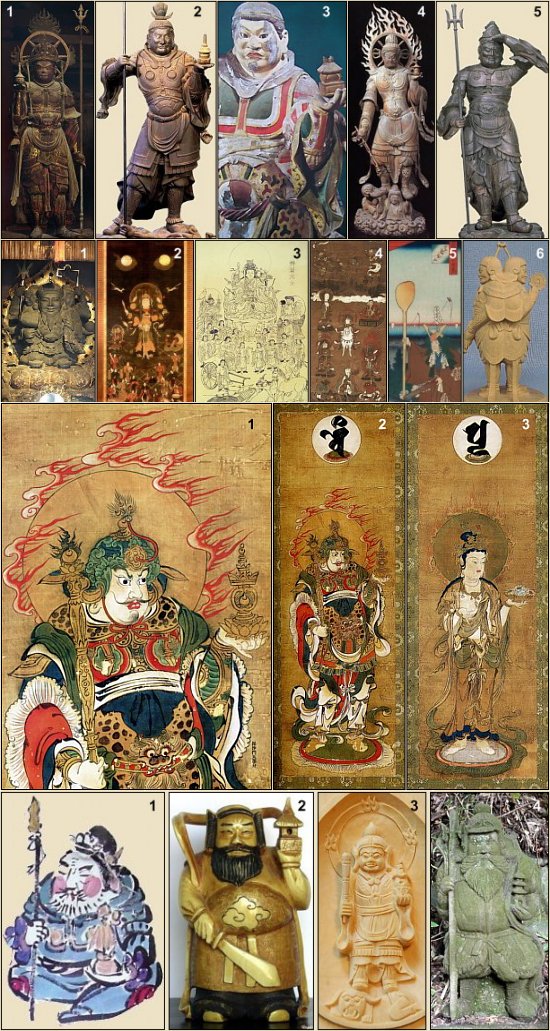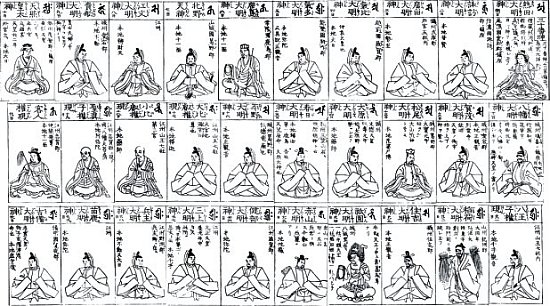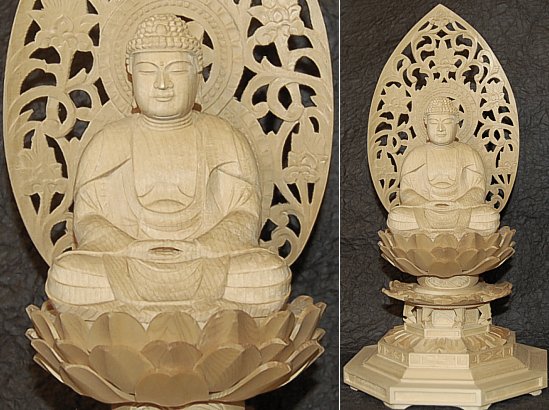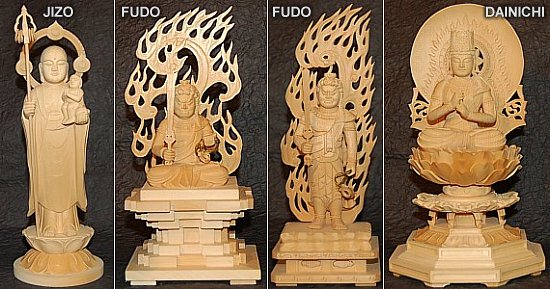June 30th, 2011
Hello Readers,
Knowledge Update for June 2011.
Updates to A-to-Z Dictionary of Japanese Deities
» Bishamonten, God of Treasure, Wealth, & Warriors
http://www.onmarkproductions.com/html/bishamonten.shtml
This month we turn our attention to Bishamonten 毘沙門天, one of Japan’s popular Seven Lucky Gods. This armor-clad, weapon-wielding, demon-stomping deity was introduced to Japan in the 6th century AD as one of Four Deva Kings Guarding the Four Directions. In this role, he was known as Tamonten 多聞天, the guardian of the north, treasure, and protector of the holy places where Buddha expounds the teachings. The Four Kings soon rose to great prominence in rites to safeguard the Japanese nation. In later centuries, however, Tamonten became the object of an independent cult, supplanting the other three in importance. When worshipped independently, he is called Bishamonten. Around the 15th century, he was enlisted as one of Japan’s Seven Lucky Gods owing to his association with treasure. Today, as one of the seven, he is often portrayed as friendly and jolly in contrast to his traditional appearance as a ferocious defender of Buddhist law. He is identified with various syncretic deities including Sanmen Daikokuten, Tenkawa Benzaiten, Shōgun Jizō, and Sōshin Bishamonten.
Come join us for an interesting ride that starts in 6th century Japan and ends in the modern day. This story features nearly 80 “clickable” photos, copious reference notes, spellings in multiple Asian languages, and a handy guide to Bishamon’s changing iconography over the past 14 centuries.

Various artwork of Bishamonten, a popular subject of painting and sculpture in Japan.
ENJOY, and gassho
mark in kamakura
Posted in Bishamonten, Uncategorized | No Comments »
May 30th, 2011
Hello Readers,
Knowledge and Product Updates for May 2011.
Updates to A-to-Z Dictionary of Japanese Deities
This month we dive deep into the heady waters of combinatory Buddha-Kami worship in Japan. For most of Japan’s recorded history, the myriad kami (local deities) were recognized as manifestations of the imported Buddhist divinities, and a great syncretic melding occurred, with temples and shrines sharing both deities and sacred grounds. This Buddha-Kami merger is known as Honji Suijaku 本地垂迹, the concept that local kami are manifestations (suijaku) of some higher universal deity (honji) and act as the local guardians of Buddhist doctrine. Alas, combinatory Buddhism-Shintoism was forcibly dismantled by the Japanese government in the Meiji Period (1868-1912), with Buddhism declared a superstitious foreign import of corruption and decadence. Buddhism’s dismantling was accompanied by the elevation of Shinto to state religion, with the emperor “turned living god” installed at the pinnacle of both political and religious power. Along the way, the architects of modern Japan fabricated a new history for the nation, one in which Shinto was portrayed as Japan’s ancient and indigenous religion.
» Sanjūbanshin 三十番神 (30 Kami Protectors of the 30 Days of the Month)
http://www.onmarkproductions.com/html/30-kami-of-the-month.html
These 30 kami are invoked to protect the peace and prosperity of the nation, its rulers, and its people, with each kami presiding over one day of the lunar 30-day month. These 30 kami are also considered guardians of the Lotus Sutra, protectors against curses, broken oaths, and the spirits of the dead. Each kami is linked to a Buddhist counterpart. The origin of this grouping is clouded in uncertainty. By tradition, it is said to have originated with Tendai monk Ennin 円仁 (794-864). <11 pages; photos of all 30 Kami and their Buddhist counterparts>

Sanjubanjin (30 Kami Tutelaries of the 30 Days of the Month)
» Sanjūnichi Hibutsu 三十日秘仏 (Secret Buddhas of 30 Days of the Month)
http://www.onmarkproductions.com/html/30-hidden-butsu.html
The 30-kami grouping discussed above is a purely Japanese convention, one that originated with the combinatory Buddha-Kami practices of Japan’s Tendai sect. Nonetheless, its conceptual basis and development probably stems from earlier Chinese influences. Most scholars believe that a similar grouping, called the Secret Buddha of the 30 Days of the Month, originated in China around the 10th century, and then spread to Japan. This latter Chinese grouping may have sparked the development of Japan’s 30-kami set, but further research is needed to determine if the two sets are related. Although this 30-Buddha grouping is largely forgotten in modern Japan, it still serves today as the primary source for the ENNICHI (holy day, monthly memorial day) of Japan’s most beloved Buddhist divinities. Saying prayers to the deity on this day is believed to bring greater merits and results than on regular days. <5 pages; photos of all 30 deities>
Updates to Buddha Statue eStore
» ONE NEW PRODUCT ADDED TO OUR ESTORE

Shaka Nyorai (the Historical Buddha)
In The News & Current/Upcoming Exhibitions
» Disaster Relief for Japan. If you haven’t given yet, please consider donating (no matter how little). Visit the Friends of Japan Web Consortium – Donation Page for a list of trustworthy relief organizations.
» Osaka City Museum of Fine Arts, Until June 6th. Kuniyoshi: Spectacular Ukiyo-e Imagination. Around 400 woodblock prints (ukiyo-e) by famed artist Utagawa Kuniyoshi (1797-1861) are on display to celebrate the 150th anniversary since his death. See the Japanese web site (with great photos) or view a short Japan Times story.
» Buddhist monk in Japan raps to attract young converts (UPI.com). Includes a few quotes from Schumacher at the end of the article.
» Edo-Tokyo Musuem. April 29 through July 3, 2011. The Five Hundred Arhats by Kano Kazunobu (1816-63). Get the exhibit catalogue before viewing the artwork, as the catalog includes English descriptions while the gallery labels do not.
» Tokyo National Museum. April 26 through June 26, 2011. Buddha – The Story in Manga and Art. Buddha, a story in manga, was produced from a decade’s work by Tezuka Osamu, the iconic manga artist renowned for such popular series as Astro Boy and Kimba the White Lion. This exhibition is the first of its kind in Japan to show original manga illustrations alongside masterpieces of Buddhist sculpture.
» Kyoto National Museum. July 16 to August 28, 2011. Creatures’ Paradise: Animals in Art from the Kyoto National Museum.
» Nara National Museum. http://www.narahaku.go.jp/english/exhibition/special.html On to India! Xuanzang’s 30,000-Kilometer Trek. July 16 through August 28, 2011.
Secret Treasures & Sacred Image of Yoki Tenman Jinja: “The Hallowed Yoki Shrine at Hatsuse.” July 16 through August 28, 2011.
» Secrets of the Silk Road Exhibition. February 5 to June 5, 2011.
http://penn.museum/china-secrets-of-the-silk-road.html
Penn Museum (Philadelphia). Secrets of the Silk Road includes two mummies and the full burial trappings of a third, representative of three different periods of time. In addition to the mummies, the exhibition features more than 100 objects that offer insight into the long and diverse cultural heritage of Central Asia—a crossroads of the Silk Road.
» A Journey to Xiangtangshan. Feb. 26 through July 31, 2011. A clip from a video featured in the exhibition “Echoes of the Past: The Buddhist Cave Temples of Xiangtangshan,” on view at the Arthur M. Sackler Gallery, Smithsonian Institution.
Posted in Uncategorized | No Comments »
April 30th, 2011
Hello Subscribers,
Knowledge and product updates for April 2011.
Updates to A-to-Z Dictionary of Japanese Deities
» DARUMA – Father of Zen Buddhism
http://www.onmarkproductions.com/html/daruma.shtml
Featuring nearly 80 photos, this 29-page special report is intended as a primer for anyone interested in Daruma (Sanskrit = Bodhidharma), the founder of Zen Buddhism. Daruma’s evolution in Japan (from Buddhahood to Brothel, from Saint to Sinner) is an amazing story involving Japanese folkloric motifs, epidemic deities, fertility, prostitutes, phallic symbols, and gender change. It includes fantastic legends of arms and legs that atrophy and fall off. In one story, Daruma falls asleep during meditation, and in anger, he plucks out his eyelids, which fall to the ground and sprout into China’s first green tea plants. Today the armless, legless, and blind Daruma doll is one of Japan’s most ubiquitous icons of good fortune. Painting in the doll’s eyes is a widespread modern practice to ensure success in business, marriage, politics, and other endeavors.

Various forms of Daruma in Japan.
Updates to Buddha Statue eStore
» SEVEN NEW PRODUCTS ADDED TO OUR ESTORE

New Products in the eStore
In The News, & Current/Upcoming Exhibitions
Let us pause for a moment to reflect on the terrible misery and suffering inflicted on Japan by the killer March 11 earthquake and tsunami. April 28th marked the 49th day since the catastrophe. In Buddhist traditions, the 49th day is of great importance — this is the day when the deceased receives his/her karmic judgment and, on the 50th day, enters the world of rebirth. Services were held around Japan to make the “passage” as favorable as possible for all those who died in the disaster. If you haven’t given yet, please consider donating (no matter how little) to disaster relief. Visit the Friends of Japan Web Consortium – Donation Page for a list of trustworthy relief organizations.
» Meetings With Remarkable People in Japan: Shuren Sakurai
Read a heartwarming story by my friend Steve Beimel (Kyoto resident) about an old Zen priest named Shuren Sakurai who carves NOH masks and embodies the Zen philosophy of simplicity, perseverance, and patience.
» A Journey to Xiangtangshan. A clip from a video featured in the exhibition “Echoes of the Past: The Buddhist Cave Temples of Xiangtangshan,” on view at the Arthur M. Sackler Gallery, Smithsonian Institution, Feb. 26-July 31, 2011.
» Safe Handling Practices for Japanese Hanging Scrolls
The FREER/SACKLER site includes other videos on handling practices for Japanese handscrolls and hanging scrolls, as well as films on other topics you might find useful and enjoyable.
» Kyoto National Museum
Honen: The Life and Art of the Founder of the Pure Land Buddhist Sect
March 26 to May 8, 2011.
Click here to read an English review of the exhibition.
» Edo-Tokyo Musuem
The Five Hundred Arhats by Kano Kazunobu (1816-63).
April 29 through July 3, 2011. Get the exhibit catalogue before viewing the artwork, as the catalog includes English descriptions while the gallery labels do not.
» Tokyo National Museum
http://www.tnm.jp/modules/r_exhibition/index.php?controller=ctg&cid=1
» Nara National Museum
http://www.narahaku.go.jp/english/exhibition/special.html
» Secrets of the Silk Road Exhibition
http://penn.museum/china-secrets-of-the-silk-road.html
February 5 to June 5, 2011. Penn Museum (Philadelphia). Secrets of the Silk Road includes two mummies and the full burial trappings of a third, representative of three different periods of time. In addition to the mummies, the exhibition features more than 100 objects that offer insight into the long and diverse cultural heritage of Central Asia—a crossroads of the Silk Road.
Posted in Daruma (Zen Patriarch), Uncategorized | No Comments »










